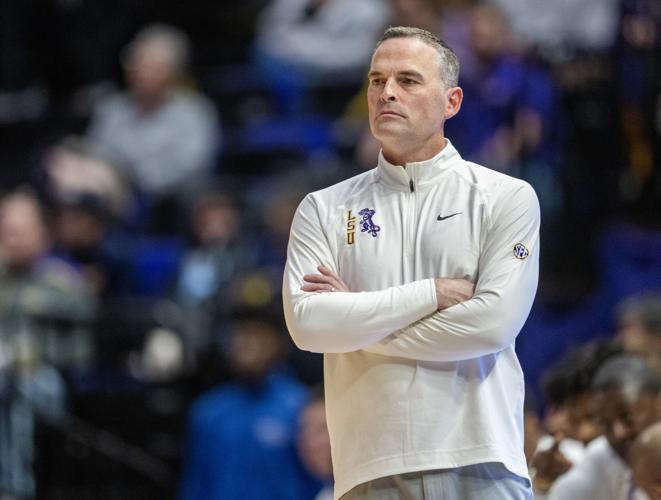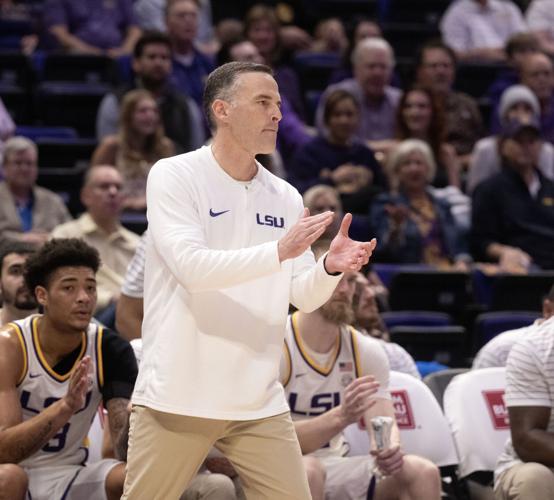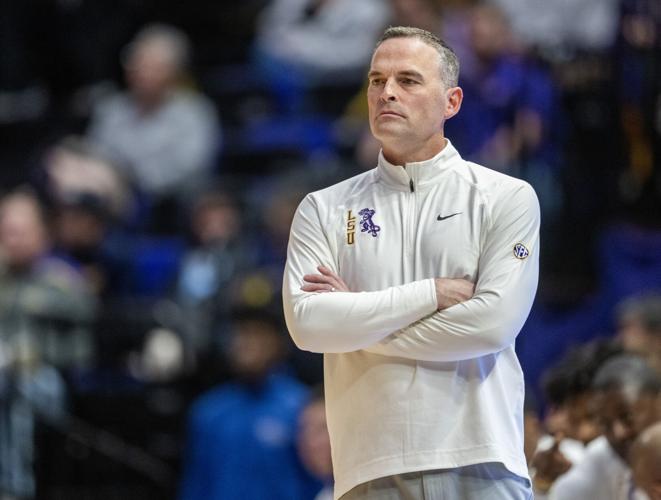It’s been nearly seven weeks since the LSU men’s basketball team closed the season with a first-round loss in the NIT. The Tigers went 17-16 overall, 9-9 in Southeastern Conference play, and tied for seventh after being picked to finish 13th. Matt McMahon’s team won seven more conference games than in his first season, so that one-year jump and the retention of several key players along with three incoming freshmen and three players from the transfer portal have McMahon looking for more in 2024-25. LSU’s third-year coach and his staff have been working since the final buzzer of that season finale, criss-crossing the country to find the players they hope will help the program take the next step. After a busy 6½ weeks, he sat down with The Advocate to talk about last season and what’s to come for the program.
Q.: In the final analysis, how did you look back on the season as a whole?
A.: I’m really excited about the progress we were able to make this season. We were the second most-improved Power 6 team in in league play, so we’re excited about the steps we were able to take. We still have a long way to go, so the focus now is what do we have to do to get better going into next season.
To finish in the top half of the SEC, to get to the postseason — even though it wasn’t the postseason we strive for — but to get there from where we started certainly is a step in the right direction. We’re excited to build on it, and I think we've been able to do that, not only through player retention, but also recruiting this spring.
Q.: After a 4-7 start in SEC play, your team won five of the final seven to go 9-9 and tied for seventh in the league. How proud were you of the staff and players’ accomplishment?
A.: I was really proud the way our players finished. On Valentine’s Day night, we missed a game-tying layup at Florida and lost to fall to 4-7. What they did from then on really speaks to the players that finished the season with us, to their character, work ethic and resiliency. We beat NCAA tournament teams like South Carolina and Kentucky despite double-digit second-half deficits, so to win those games and get in the top half of the SEC standings was a strong finish.
Q.: Do you believe the roots are firmly planted now?
A.: No doubt. I love where the culture of the program is and I'm excited to have back Tyrell Ward, Jalen Reed and Derek Fountain, who’ll be in their third year in the program. I believe continuity is a competitive advantage in college basketball and we've added a great mix of high school talent — three of the top 65 players in the country — and we’ve added add experience and leadership through the transfer portal. We think they can add some winning qualities and help us improve in areas we struggled a year ago — perimeter defense and assist to turnover ratio. I’m excited where we’re at.
Q.: What’s happened since the end of the season, both for the staff and your returning players?
A.: The spring is critical for two areas: Recruiting gets a lot of attention, but I'm just such a believer in player development. Player development leads to player retention in today's college basketball world, so we’ve invested a lot of time with our returning players this spring. It's been really good; our players have worked extremely hard to get better and improve in taking advantage of the offseason player development program.
Q.: The staff has been on the road for the past month. Is it going to settle down a little since the transfer portal closed May 1?
A.: When the final buzzer went off and the season is over, it was just nonstop until the portal closed. So it's just been nonstop recruiting and working with our returning players. Hopefully, when we get through final exams next week, there will be a day or two to at least catch our breath and start planning for the summer.
Q.: You have 12 scholarship players now, one less than the NCAA-allowed 13 because of the penalties from the previous coaching staff. Could there be another move?
A.: I don't think you're ever done. We're going to keep working on this roster because we’re always looking to improve our team and get better. But yes, this is the final penalty from the NCAA’s ruling last summer.
Q.: Turning to the players you got out of the portal — Cam Carter, Jordan Sears and Dji Bailey — how did you identify them and go about signing them?
A.: You can’t work them out, but there’s Zoom, film study, analytics study, character study. NIL is the dominating theme these days, but the evaluation piece still matters. You can bring them in for an official visit, and all three came in for a visit.
Q.: (Forward) Dailion Collins played in just six games before suffering a season-ending shoulder injury. How is he coming along?
A.: Daimion received a medical redshirt from the NCAA, so he’ll be a redshirt junior and will have two years of eligibility remaining.
Q.: The schedule is taking shape (home games with UL-Monroe and UNO, a game at Kansas State, and an opponent TBA for a home game in the ACC/SEC Challenge) with the most recent addition being the inaugural Greenbrier Tip-Off. How do you feel about it so far?
A.: We’ll have some more contracts coming in soon, but the Greenbrier is going to be fun. It’s a great field with three Power 6 schools (Wisconsin, Pittsburgh and Central Florida), so we’re guaranteed of playing two Power 6 opponents there. The goal is always to win games and prepare for league play, but you want to provide your players with unique and great experiences. It’s the world-famous Greenbrier Resort. I haven’t been there, but I wanted to get back closer to home for Tyrell Ward (Washington, D.C.) and Mike Williams (Baltimore) so their family and friends could see them play close to home. It checked a lot of boxes; those are the type of events we want to play.




